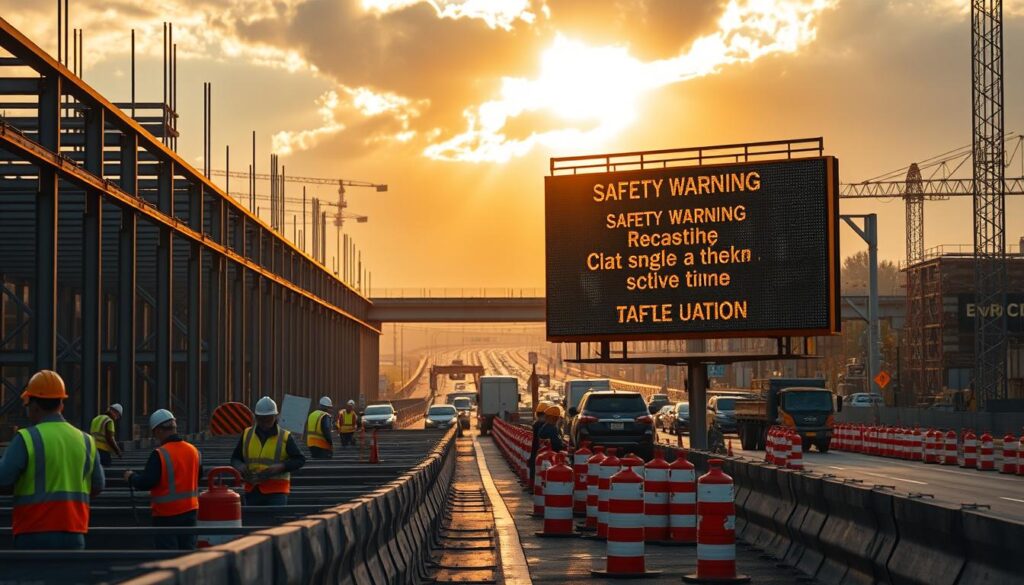Did you know the biggest Variable Message Sign (VMS) is 3.8 meters high and 20.5 meters wide? It’s near Sydney Airport. This huge digital sign shows how important real-time messages are for traffic. VMS Message Boards are changing how we keep roads safe and inform drivers.
These systems give drivers quick updates on road conditions. They also help drivers and construction teams talk better. Companies like Revlo are using these smart solutions to make traffic flow better and cut down on accidents. With over 50 years of making polycarbonate and optical systems, VMS is proven to work well.
The design of digital signage makes it easy to see and use in many places. It’s perfect for busy areas and work zones. To learn more about how VMS is making roads safer, check out this resource.
Understanding Variable Message Signs (VMS)
Variable Message Signs (VMS) are key to modern traffic systems. They show important info like road conditions and traffic changes. These signs help manage traffic and keep roads safe.
Definition and Purpose
VMS help manage traffic by showing real-time updates. They use data from sensors and cameras to inform drivers. This helps avoid accidents and keeps traffic moving.
They also show speed limits and lane closures. This encourages drivers to drive safely. It’s all about making roads safer and smoother.
Types of VMS: Fixed vs. Portable
VMS are either fixed or portable. Fixed signs are always there, while portable ones pop up for events or construction. Portable signs are great for quick updates.
New tech like LED displays and solar power make VMS better. They’re becoming more popular in smart traffic systems. For more on VMS, check out this resource.
The Role of VMS in Dynamic Traffic Management
Variable Message Signs (VMS) are key in managing traffic. They share real-time updates on road conditions, detours, and lane closures. This helps keep drivers safe and traffic moving smoothly.
Real-Time Messaging Benefits
VMS keep drivers informed with the latest updates. This reduces confusion and delays. They can show messages for different situations, like construction zones or city streets.
The signs can change colors and message length. This makes them effective in keeping drivers safe and reducing accidents.
Impact on Traffic Flow and Congestion Reduction
VMS help manage traffic, even during big incidents. They guide vehicles to avoid jams, saving time and reducing stress. Studies show real-time info can lower accident rates by preparing drivers.
Using VMS helps control congestion and keeps roads safe. Following traffic safety rules is essential for the best results in managing traffic and incidents.
VMS Message Board: A Game Changer for Work Zones
Variable Message Signs (VMS) have greatly improved safety in construction zones. These electronic signs warn drivers about dangers like moving equipment and workers. They also alert drivers to changes in traffic patterns.
The clear messages on VMS help prevent accidents. This makes the work area safer for everyone. Plus, they provide updates in real-time, keeping drivers and workers informed.
Enhancing Construction Zone Safety
Variable Message Signs play a big role in keeping construction zones safe by:
- Alerting drivers to current conditions and possible dangers.
- Reducing confusion during heavy traffic and roadwork.
- Communicating quickly about changes in traffic.
Improving Communication for Workers and Drivers
Good communication is key in construction zones. VMS help by:
- Showing timely info about construction schedules and delays.
- Helping traffic flow smoothly by guiding vehicles.
- Providing updates on events around construction.
To learn more about VMS in different settings, check out this useful resource.

Technological Advances Behind VMS
Recent changes in variable message signs (VMS) focus on LED technology. This change is a big step up from old lighting systems. It brings many benefits for managing traffic and sharing information.
LED VMS stands out because they show messages clearly and brightly. This is true even in different weather conditions.
LED Technology and Its Advantages
LED technology has made VMS better by using less power and lasting longer. They are brighter than old lights, making messages easier to see. This is great for all kinds of weather.
LEDs can also show full-color graphics, making messages clearer and more engaging. They are also good for the environment because they use less energy. This helps reduce carbon emissions, which is good for our planet.
- Dynamic Updates: LED VMS can change messages quickly, helping traffic flow better.
- Remote Control: Modern designs let you update messages easily, making things more efficient.
- Durability and Low Maintenance: Even though LED VMS cost more upfront, they save money in the long run because they last longer and need less upkeep.
Solar-Powered VMS for Eco-Friendly Solutions
Solar-powered VMS are a great choice for the environment. They use the sun’s energy, which is clean and renewable. This means they don’t rely as much on traditional power sources.
These systems adjust how much energy they use based on the light and what they’re showing. This makes them a good fit for smart cities, helping them work better and be more efficient.
The future looks bright for VMS, with more connections to IoT devices. This will make managing traffic even better. Predictive analytics will help make sure messages are always relevant and timely.
There’s also a move towards using eco-friendly materials and designs. This shows a commitment to protecting the environment while keeping up with digital signage standards.
Real-World Applications of VMS
Variable Message Signs (VMS) are key in traffic management, seen often in construction sites and at special events. They give real-time updates that are vital for keeping traffic safe and improving work zone flow. Here, we’ll look at how VMS are used in real-life situations.
Use in Construction Sites
In construction areas, VMS are essential for managing traffic and keeping workers safe. They share important details like detours, lane closures, and project schedules. This info is key for drivers to navigate work zones smoothly.
The smart placement of VMS helps cut down on traffic jams. This reduces the usual delays caused by construction.
- They tell drivers about current conditions, helping to avoid sudden stops.
- Good communication through VMS helps drivers follow traffic rules better.
- Dynamic messages can change with the situation, keeping traffic safe in real-time.
Application During Special Events
At special events, VMS are vital for handling the extra traffic and keeping attendees safe. They share info on parking, road closures, and other routes. This helps vehicles move more smoothly.
This clear communication helps avoid accidents and makes getting around safer.
- VMS help control crowds by guiding people well.
- They prevent confusion by updating drivers quickly.
- Working well with event plans makes traffic safer.
Benefits of Implementing VMS in Work Zones
Using Variable Message Signs (VMS) in work zones brings big benefits. It helps cut costs and improves traffic flow. These signs do tasks that people used to do, saving money. They also help use resources better for safety.
Cost Reduction in Traffic Management
Adding VMS to work zones lowers costs for traffic management. For example, the Georgia Department of Transportation (GDOT) has about 6,800 traffic signals. VMS can update these signals automatically, saving money. This cuts down on labor costs and makes traffic flow better.
Enhancing Overall Traffic Safety
VMS makes communication between drivers and traffic systems better. It helps make quick decisions during roadwork, making roads safer. For instance, VMS warns drivers about road hazards, making them more aware and safe.
Also, using solar-powered VMS is good for the environment. It also saves money in the long run because it needs less maintenance.
Conclusion
The VMS Message Board is a big step forward in traffic management, mainly in work zones. It gives drivers real-time updates, making roads safer and more efficient. The National Highway Traffic Safety Administration found that roads with LED VMS have fewer accidents than those with old signs.
This change is making traffic management smarter and more flexible. It’s all about responding quickly to traffic needs.
LED technology makes sure drivers see important messages, even in the daytime. This helps drivers react faster, making traffic flow better and reducing jams. Using VMS also saves money because LED lights use less energy.
As technology gets better, VMS Message Boards will play an even bigger role. They will work with new tech like machine learning and AI. This will help cities handle today’s traffic problems better.
These updates will make traffic smoother and safer. For more on how new tech is changing construction and project management, check out this article.



